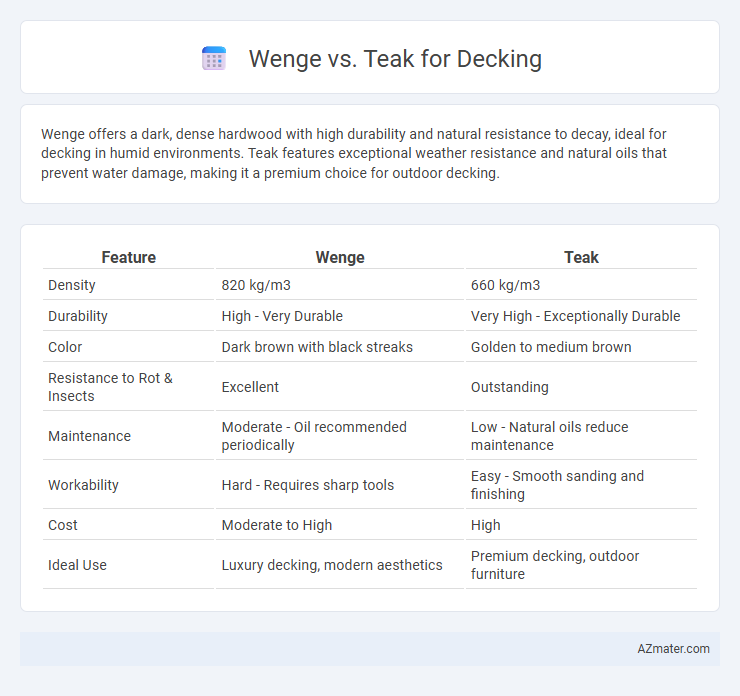Wenge offers a dark, dense hardwood with high durability and natural resistance to decay, ideal for decking in humid environments. Teak features exceptional weather resistance and natural oils that prevent water damage, making it a premium choice for outdoor decking.
Table of Comparison
| Feature | Wenge | Teak |
|---|---|---|
| Density | 820 kg/m3 | 660 kg/m3 |
| Durability | High - Very Durable | Very High - Exceptionally Durable |
| Color | Dark brown with black streaks | Golden to medium brown |
| Resistance to Rot & Insects | Excellent | Outstanding |
| Maintenance | Moderate - Oil recommended periodically | Low - Natural oils reduce maintenance |
| Workability | Hard - Requires sharp tools | Easy - Smooth sanding and finishing |
| Cost | Moderate to High | High |
| Ideal Use | Luxury decking, modern aesthetics | Premium decking, outdoor furniture |
Introduction to Wenge and Teak for Decking
Wenge decking is valued for its deep, rich brown color with striking black grain patterns, offering exceptional durability and natural resistance to decay and insects. Teak decking, known for its golden-brown hue and high oil content, provides outstanding weather resistance, low maintenance, and a smooth, non-slip surface ideal for outdoor environments. Both hardwoods are prized in decking applications for their strength, longevity, and aesthetic appeal, with Wenge delivering a darker, more exotic look, while Teak offers warmth and classic elegance.
Wood Appearance: Wenge vs Teak
Wenge exhibits a rich, dark brown to black hue with fine, straight grain and a slightly coarse texture, offering a bold and dramatic look for decking. Teak features a warm golden-brown color with a straight grain pattern and natural oily finish, giving decks a classic, elegant appearance that weathers to a silver-gray patina over time. Both woods provide distinct aesthetic qualities, with Wenge delivering a modern, striking contrast and Teak offering timeless warmth and durability for outdoor decking projects.
Durability and Lifespan Comparison
Wenge and teak are both popular hardwoods for decking, prized for their exceptional durability and resistance to wear. Wenge offers a high density and natural oil content, making it highly resistant to moisture, insects, and decay with a typical lifespan of 25 to 30 years when properly maintained. Teak's renowned longevity stems from its rich oil reserves and tight grain structure, allowing it to resist rot and weathering for up to 40 years or more, often outperforming wenge in splash zones and humid climates.
Resistance to Weather and Insects
Wenge wood offers exceptional resistance to weather and insects due to its dense grain and natural oils, making it highly durable for outdoor decking. Teak is also renowned for its superior weather resistance and insect-repellent properties, attributed to its high silica content and natural oils that prevent decay and termite damage. Both woods perform well in outdoor environments, but teak's proven track record and ease of maintenance make it a top choice for long-lasting decking solutions.
Maintenance and Care Requirements
Wenge decking demands regular cleaning and oiling to maintain its rich dark color and prevent surface drying, with natural oils helping resist moisture and insects. Teak decking requires minimal maintenance due to its high natural oil content, which protects against rot, warping, and pests, but periodic cleaning and optional oiling preserve its golden hue. Both woods benefit from proper sealing and avoid prolonged water exposure to extend lifespan and retain aesthetic appeal.
Cost and Availability
Wenge decking tends to be more expensive than teak due to its exotic status and limited availability outside of Africa, often costing between $15 to $25 per square foot. Teak is more readily available globally, especially from Southeast Asia, with prices typically ranging from $10 to $20 per square foot, making it a more cost-effective option for large decking projects. Availability of both woods can vary seasonally, but teak's sustainable plantations contribute to steadier supply and more competitive pricing compared to the rarer wenge.
Sustainability and Environmental Impact
Wenge decking, sourced from African tropical forests, often faces sustainability concerns due to illegal logging and habitat destruction, while teak, primarily cultivated in managed plantations, offers a more renewable option with certifications like FSC ensuring responsible harvesting. Teak's natural resistance to pests and decay reduces the need for chemical treatments, lowering environmental impact compared to wenge, which may require more intensive preservation methods. Choosing FSC-certified teak supports sustainable forestry practices and helps protect biodiversity, making it a more eco-friendly choice for decking projects.
Ease of Installation
Wenge offers moderate ease of installation due to its density and hardness, requiring pre-drilling to prevent splitting and specialized tools for cutting. Teak is highly valued for decking installation because of its natural oils that resist warping and ease of fastening without frequent pre-drilling. Both woods demand professional skills, but teak's smoother grain and stability generally reduce installation time compared to wenge.
Best Uses and Applications
Wenge's dense grain and rich dark color make it ideal for outdoor decking in tropical climates where durability against moisture and insects is crucial, often favored for high-traffic areas and modern design aesthetics. Teak's natural oils and high resin content offer exceptional resistance to water, rot, and UV damage, making it the preferred choice for pool decks, marine environments, and luxury outdoor furniture. Both woods excel in longevity and weather resistance, but Wenge suits bold architectural statements while Teak delivers timeless elegance and minimal maintenance.
Final Recommendation: Choosing the Right Wood
Wenge offers exceptional hardness and rich dark tones that resist wear, making it ideal for high-traffic decking areas, while teak provides superior natural oil content for excellent water resistance and longevity. Both woods are durable and visually striking, but teak's lower maintenance and proven outdoor performance often make it the preferred choice for long-lasting decks. Selecting the right wood depends on balancing desired aesthetics, environmental conditions, and maintenance capacity to ensure optimal deck durability and beauty.

Infographic: Wenge vs Teak for Decking
 azmater.com
azmater.com